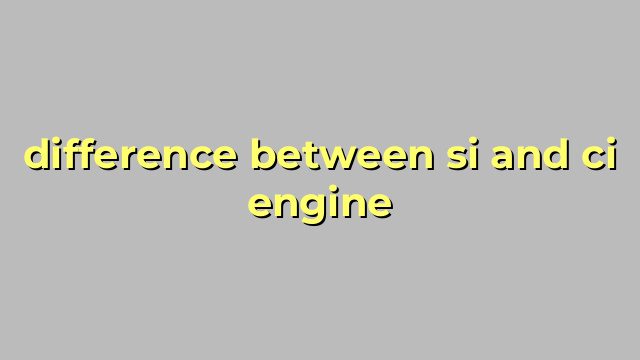Differences Between SI and CI Engines That You Must Know
When it comes to internal combustion engines, there are two primary types: spark-ignition (SI) and compression-ignition (CI). Both types of engines have different characteristics, and it’s essential to understand each of them to know which one is suitable for your needs. In this article, we’ll discuss the differences between SI and CI engines to help you make an informed decision.
SI Engine
Spark-ignition engines are commonly found in vehicles such as cars and motorcycles. These engines rely on a spark plug to ignite a mixture of air and fuel. The spark plug produces a spark that ignites the fuel in the engine’s combustion chamber, which produces energy that powers the engine. SI engines are typically smaller than their CI counterparts and produce less power.
The primary advantage of an SI engine is its ability to start quickly and operate smoothly at low speeds. They are more fuel-efficient than CI engines and emit fewer pollutants. However, they require a consistent supply of high-quality fuel and regular maintenance to ensure proper operation.
CI Engine
Compression-ignition engines are commonly found in larger vehicles such as trucks and buses. These engines use pressure, rather than a spark, to ignite the fuel in the combustion chamber. CI engines compress a mixture of air and fuel until the temperature reaches a high enough level to ignite the fuel, which produces energy that powers the engine. CI engines are typically more massive and produce more power than SI engines.
The primary advantage of a CI engine is its ability to work efficiently even under adverse conditions. They can operate on lower-quality fuel and require less maintenance than SI engines. However, they produce more pollutants and require a higher initial capital investment.
Conclusion
Both SI and CI engines have their advantages and disadvantages. SI engines are commonly used in smaller vehicles, while CI engines are typically used in larger vehicles. SI engines are more fuel-efficient and produce fewer pollutants, but they require high-quality fuel and regular maintenance. CI engines can work under adverse conditions, require less maintenance, but produce more pollutants. Ultimately, the choice between an SI and CI engine will depend on your specific needs and the application for which you intend to use the engine.
Table difference between si and ci engine
| Parameter | SI Engine | CI Engine |
|---|---|---|
| Working Principle | Spark Ignition | Compression Ignition |
| Fuel/Air Mixture | Homogeneous | Heterogeneous |
| Compression Ratio | Lower compression ratio | Higher compression ratio |
| Ignition Timing | Controlled by spark plug | Self-ignition by pressure and temperature |
| Power Output | Lower power output | Higher power output |
| Emissions | Higher emissions of CO and unburnt hydrocarbons | Lower emissions of CO and unburnt hydrocarbons |
| Fuel Efficiency | Lower fuel efficiency | Higher fuel efficiency |
| Cost | Lower initial cost | Higher initial cost |
